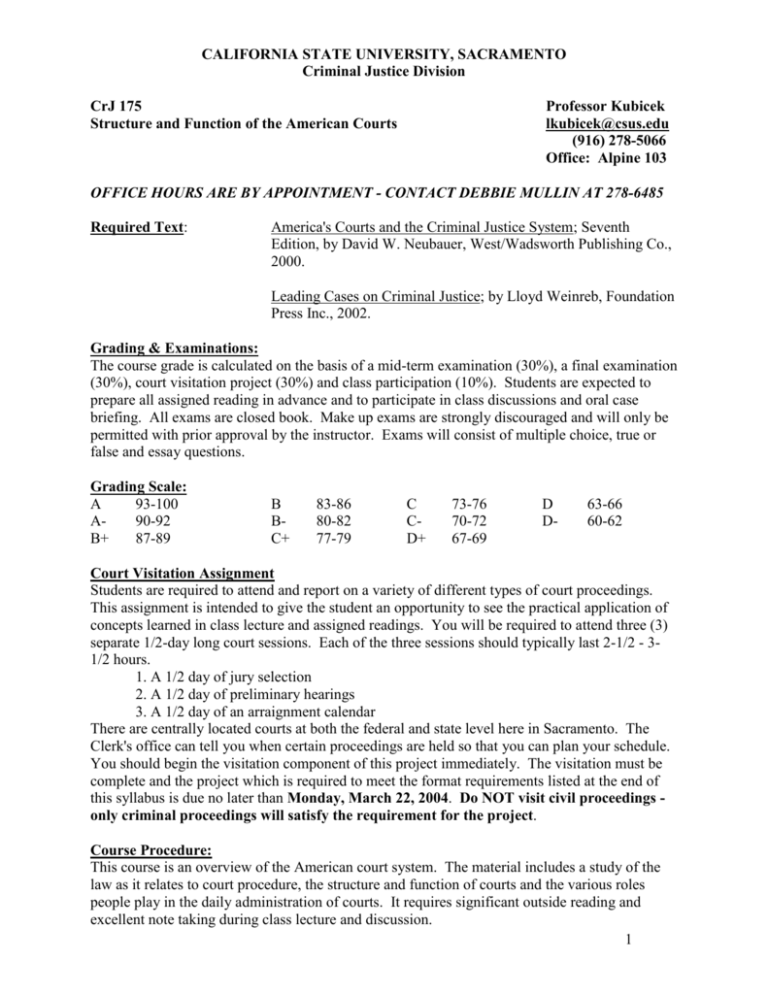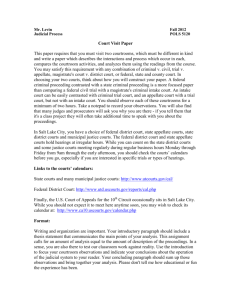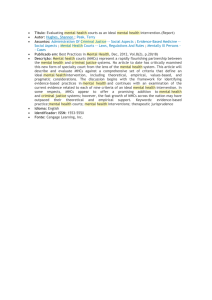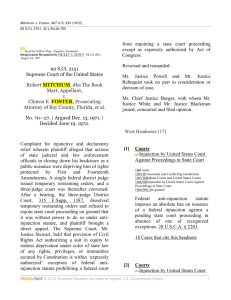CALIFORNIA STATE UNIVERSTY, SACRAMENTO
advertisement

CALIFORNIA STATE UNIVERSITY, SACRAMENTO Criminal Justice Division CrJ 175 Structure and Function of the American Courts Professor Kubicek lkubicek@csus.edu (916) 278-5066 Office: Alpine 103 OFFICE HOURS ARE BY APPOINTMENT - CONTACT DEBBIE MULLIN AT 278-6485 Required Text: America's Courts and the Criminal Justice System; Seventh Edition, by David W. Neubauer, West/Wadsworth Publishing Co., 2000. Leading Cases on Criminal Justice; by Lloyd Weinreb, Foundation Press Inc., 2002. Grading & Examinations: The course grade is calculated on the basis of a mid-term examination (30%), a final examination (30%), court visitation project (30%) and class participation (10%). Students are expected to prepare all assigned reading in advance and to participate in class discussions and oral case briefing. All exams are closed book. Make up exams are strongly discouraged and will only be permitted with prior approval by the instructor. Exams will consist of multiple choice, true or false and essay questions. Grading Scale: A 93-100 A90-92 B+ 87-89 B BC+ 83-86 80-82 77-79 C CD+ 73-76 70-72 67-69 D D- 63-66 60-62 Court Visitation Assignment Students are required to attend and report on a variety of different types of court proceedings. This assignment is intended to give the student an opportunity to see the practical application of concepts learned in class lecture and assigned readings. You will be required to attend three (3) separate 1/2-day long court sessions. Each of the three sessions should typically last 2-1/2 - 31/2 hours. 1. A 1/2 day of jury selection 2. A 1/2 day of preliminary hearings 3. A 1/2 day of an arraignment calendar There are centrally located courts at both the federal and state level here in Sacramento. The Clerk's office can tell you when certain proceedings are held so that you can plan your schedule. You should begin the visitation component of this project immediately. The visitation must be complete and the project which is required to meet the format requirements listed at the end of this syllabus is due no later than Monday, March 22, 2004. Do NOT visit civil proceedings only criminal proceedings will satisfy the requirement for the project. Course Procedure: This course is an overview of the American court system. The material includes a study of the law as it relates to court procedure, the structure and function of courts and the various roles people play in the daily administration of courts. It requires significant outside reading and excellent note taking during class lecture and discussion. 1 Student Assistance: The university has a Skills Center in Lassen Hall, available to assist you as needed with study skills – do not hesitate to take advantage of this resource if you feel you will need the help. There is also an English Writing Center in Calaveras Hall, room 128, where you can be assigned a tutor to help strengthen your writing skills. If you have a disability and require accommodations, you need to provide disability documentation to SSWD, Lassen Hall 1008, (916) 278-6955. Please discuss your accommodation needs with me after class or during my office hours early in the semester. You also have access to a criminal justice writing tutor through the CJ Student Services Office in Alpine Hall, Room 114. Plagiarism Students in this course will be held to the highest standard of personal accountability with regard to issues of plagiarism and cheating. If you engage in either plagiarism or cheating on course work or examinations you will fail this course and will be referred to the Office of Student Affairs for University level discipline. The learning objectives of this course are as follows: Upon conclusion of the course and diligent study of the assigned material, successful students will be able to demonstrate a thorough understanding of the structure and function of the American Courts. The course is inclusive of both the federal and state systems. You will develop a detailed knowledge of the Bill of Rights as it relates to constitutional criminal procedure. The particular subject matter is outlined below in each specified reading assignment. Student writing skills should be enhanced through the preparation of case briefs, participation in predominantly essay format exams, and completion of a court visitation assignment with a report. The specific objectives include but are not limited to: 1. Demonstrate analysis of complex law cases together with logical reasoning requisite to their application to legal contextual situations. 2. Demonstrate a thorough understanding of the structures and functions of the American Court Sysem(s). 3. Describe our common law heritage together with state-federal sources of law, jurisdiction, venue, civil law and civil liability concepts in criminal justice, state and federal court organization, judicial administration and the hierarchy of courts. 4. Express an understanding of the courthouse workgroup, roles of the prosecutor, defense attorney, judge, probation officials, victims and witnesses. 5. Conduct and report observations of criminal court proceedings in order to garner an understanding of the courtroom, arraignments, preliminary hearings, trials, motions, jury selection, bail and pre-trial release, discovery, pleas, negotiated justice, sentencing decisions, appeals as a right and a matter of judicial discretion. 6. Identify the usage of the Grand Jury at federal and state levels together with its advantages disadvantages. 7. Demonstrate knowledge and understanding of Constitutional Rights associated with criminal legal process including juvenile courts i.e. those engendered by the Fourth, Fifth, Sixth, Eight, and Fourteen Amendments. 2 Class Assignments and Exams by Week: This schedule is intended as a guide and is subject to change by the instructor as necessary. Week 1 Chapter Book 1 T C C 2 2 2 2 2 T C T T 3 5 3 6 4 4 7 4 5 8 9 T T 5 5 10 T C 6 6 6 6 11 T C T C 7 13 T 8 14 T 3 4 12 8 9 9 10 11 11 T C T C T C C 15 16 17 T C T T C Topic/Case INTRODUCTION Crime, Courts & Controversy 14th Amendment Rochin v. California A. The Legal System Law & Crime The Federal Courts The State Courts B. Legal Actors The Courthouse and People Who Work There Barker v. Wingo Prosecutors, Discretion Immunity, etc. U.S. v. Armstrong Defense Attorneys, Right to Counsel, etc. Gideon v. Wainwright Douglas v. California Faretta v. California Ross v. Moffit Judges Defendants & Victims C. Processing the Accused Arrest to Arraignment Coleman v. Alabama Gerstein v. Pugh County of Riverside v. McClaughlin Bail Issues Stack v. Boyle, U.S. v. Salerno Disclosing & Suppressing Evidence Mapp v. Ohio Taylor v. Illinois Negotiated Justice Mid Term Exam Trials and Juries Illinois v. Allen; Estelle v. Williams, Sheppard v. Maxwell Pointer v. Texas U.S. v. Agurs Victor v. Nebraska Sentencing Options Gregg v. Georgia Sentencing Decisions Appellate Courts Ashe v. Swenson Pages 1-23 2 25-32 26-57 1-2 58-88 89-110 112-136 856-865 137-165 881-887 166-190 574-577 578-584 635-641 596-604 191-218 220-242 246-273 848-852 853-860 861-866 274-297 867-880 298-320 340-353 1015-1022 322-347 348-380 958-984 992-994 1023-1030 1035-1042 383-449 1109-1134 415-449 452-477 1043-1047 3 Week 12 13 14 15 Chapter 18 19 Book T T Topic/Case The Lower Courts Juvenile Courts Catch Up Week Review Week Final Examination - Tuesday, 12/16 - 12:45 pm Pages 478-500 501-528 COURT VISITATION ASSIGNMENT - CRJ 175 For each of the three proceedings you are required to visit for this project you must prepare a separate summary to be included in your project. For each type of proceeding you must begin by doing the following: 1. Visit the library and consult the Index to Legal Periodicals. Find and select a law review article about the proceeding you are going to visit. Choose an article published after 1990. 2. Review the chapter in the text which describes the type of proceeding you plan to visit. 3. Conduct your court visit after you have read the above items. Using the information acquired during your visit and through your readings, prepare a report for each observation. Each report should contain the following components: 1. The name, address, date and department of the court 2. The name of the judge who presided over the session 3. A summary of the proceedings 4. An evaluation The evaluation should focus on a comparison between what you have read and what you actually observed. Was your visitation experience similar or different from your expectations? What opinions did you garner from the visit? Describe the quality of the proceedings and the participants. Format & Page Limits: Your papers must each be entirely your own work. The paper must have a title page and a listing of works cited for each text chapter and law review article you cite. The paper must be type written and use 12 point font with no larger than 1" page margins. Your entire project (all three summaries) must be between 10-12 pages. Important Criteria: You paper will be graded on preparation of the project, your use of an appropriate source for your research component and your use of the text. You will also be graded on you thoughtful assessment of the proceeding itself as well as your completion of the visitation description (court, address, etc.) You are required to include the title page and works cited. You will also be graded on your basic college level writing skills including organization, neatness, spelling and Standard English grammar and usage. 4










